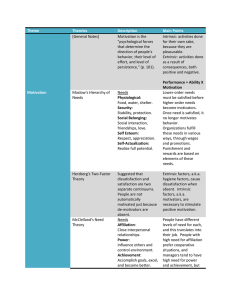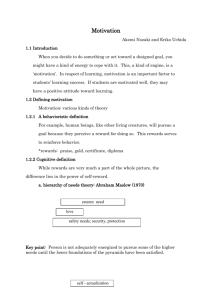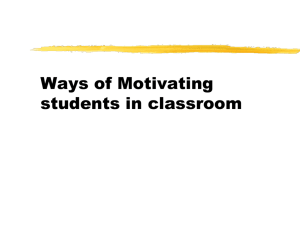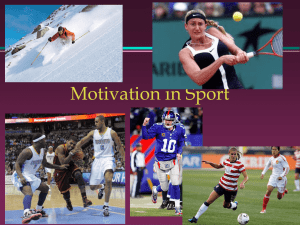Motivation
advertisement
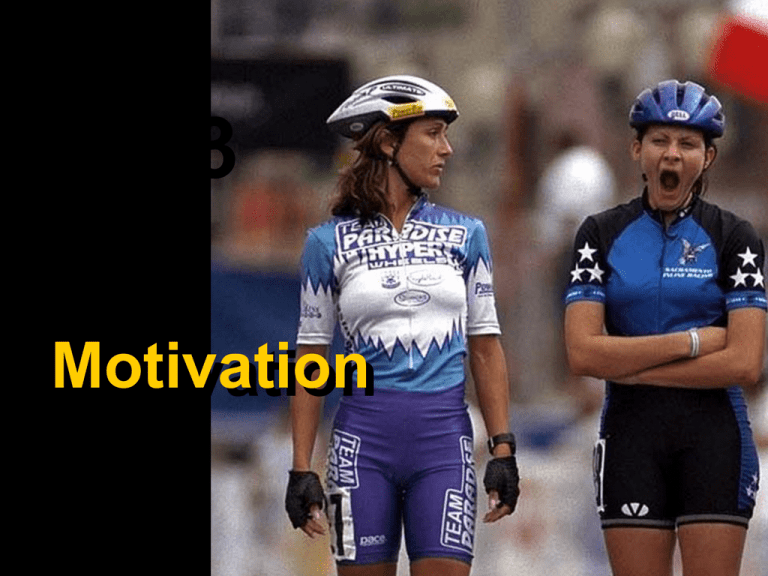
3 Motivation Motivation What Is Motivation? Motivation is the direction and intensity of effort. Direction of effort: Whether an individual seeks out, approaches, or is attracted to a situation. Intensity of effort: How much effort an individual puts forth in a situation. What motivates and guides your life? What motivates you in sport/exercise? Views of Motivation Participant– or Trait–Centered View Motivated behavior is primarily a function of individual characteristics (e.g., needs, goals, personality). Views of Motivation Situation–Centered View Motivated behavior is primarily determined by situational factors. Interactional View of Motivation Major Motives for Sport Participants Improving skills Having fun Being with friends Experiencing thrills and excitement Achieving success; competitive outlet Developing fitness Major Motives for Exercise Participants Joining Continuing Health factors Enjoyment Weight loss Like instructor Fitness Like type of activity Self-challenge Social factors Feeling better What Are Achievement Motivation and Competitiveness? Achievement motivation An individual’s orientation to strive for task success, persist in the face of failure, and experience pride in accomplishments. (Gill, 1986) Why Achievement Motivation Is Important Achievement motivation influences choice of activities effort to pursue goals intensity of effort persistence (in the face of failure) Competitiveness “A disposition to strive for satisfaction when making comparisons with some standard of excellence in the presence of evaluative others.” (Martens, 1986) What Are Achievement Motivation and Competitiveness? Keys: Competitiveness = Social evaluation or comparison Achievement motivation = Self-comparison or achievement Theories of Achievement Motivation Early Theories of Achievement Motivation: Instinct Theory Drive Theory Need achievement theory Need Achievement Theory Contemporary Theories of Achievement Motivation: Self-Efficacy Theory Attribution theory Achievement goal theory Competence motivation theory Self–Efficacy Theory... Bandura Self–Efficacy The perception of one’s ability to perform a task successfully is really a situation-specific form of self-confidence. Self–Efficacy Sources Potential Sources of Influence & Motivation Among Elite Athletes •Gould et al. Study: interviews of 10 current/former Olympic champions, 1980 - 1998 games (28/32 medals won gold) • used “triangulation” (S.O.s & coaches) • Sources of Influence: – – – – community individual dev’t (genetics; maturity etc.) non-sport people sport people (agents, coaches, competitors, former elite players) – the sport process (success in competition) Attribution Theory Attributions Attribution categories How people explain their successes and failures Stability Locus of causality Locus of control Attribution Theory Weiner’s basic attribution categories Attributions and Achievement Motivation Attributions Psychological result Stable Increased expectation of success Internal cause Increased pride or shame In one’s control Increased motivation Achievement Goal Theory Achievement goals Outcome goal orientation (or competitive goal orientation) Task goal orientation (or mastery goal orientation) Achievement Goal Theory + Achievement Goal Theory Keys: Focus extra attention on task-oriented goals. Foster mastery or task motivational climates. Competence Motivation Theory (Cognitive Evaluation Theory) Competence Motivation Theory Keys: People are motivated to feel worthy or competent. Feelings of competence and worth, as well as perceptions of control, determine motives. What Theories of Achievement Motivation Tell Us About High Achievers Motivational orientation High motivation to achieve success Low motivation to achieve failure Focuses on the pride of success What Theories of Achievement Motivation Tell Us About High Achievers Attributions Ascribes success to stable and internal factors within one’s control Ascribes failure to unstable and external factors outside one’s control Goals adopted Usually adopts task goals What Theories of Achievement Motivation Tell Us About High Achievers Perceived competence/ control Has high perceived competence and feels that achievement is within his or her control Task choice Seeks out challenges and able competitors/tasks Performance Performs well in evaluative conditions Intrinsic Motivation and Extrinsic Rewards Intrinsic motivation: Striving inwardly to be competent and self-determining. (e.g., geena davis “It’s just fun to see how good you can get.”) Basic question: Do extrinsic rewards undermine intrinsic motivation? Some research shows that being paid for working on an intrinsically interesting activity can decrease a person’s intrinsic motivation for the activity. Intrinsic Motivation and Extrinsic Rewards Cognitive Evaluation Theory How rewards are perceived is critical in determining whether intrinsic motivation increases or decreases. Cognitive Evaluation Theory Controlling aspects: Rewards that are perceived to control a person or suggest the person is not competent decrease intrinsic motivation. Informational aspects: Rewards that increase the information aspect and provide positive feedback about competence increase intrinsic motivation. (continued) Cognitive Evaluation Theory Success and failure: Competitive success increases intrinsic motivation, whereas competitive failure decreases intrinsic motivation. Function and significance: How a reward affects intrinsic motivation depends on whether the recipient perceives it to be more controlling or more informational. How Extrinsic Rewards Affect Intrinsic Motivation in Sport Scholarships: Athletic scholarships can either decrease or increase athletes’ levels of intrinsic motivation, depending on which is more emphasized—the controlling or informational aspects. Guidelines for Building Motivation • Emphasize mastery (task) goals and downplay outcome goals. • Monitor and correct inappropriate attributions. • Praise, reinforce liberally • Determine when competitive goals are appropriate. • Enhance feelings of competence and control. Guidelines for Building Motivation Guideline 1 • Recognize the interaction of personal and situational factors influencing achievement behavior. Goal orientation Primary attributions Situations approached or avoided Guidelines for Building Motivation Guideline 2 People have multiple motives for involvement. Understand why people participate in physical activity. People participate for more than one reason. People may have competing motives for involvement. People have both shared and unique motives. Motives change over time. Guidelines for Building Motivation Guideline 3 Change the environment to enhance motivation. Environment may be competitive or recreational. Provide for multiple motives and opportunities. Adjust to individuals within groups. Guidelines for Building Motivation Guideline 4 Leaders influence motivation, directly and indirectly. Guidelines for Building Motivation Guideline 5 Use behavior modification (contingency mangment) to change undesirable participant motives. Systematic application of the basic principles of reinforcement to change behavior

